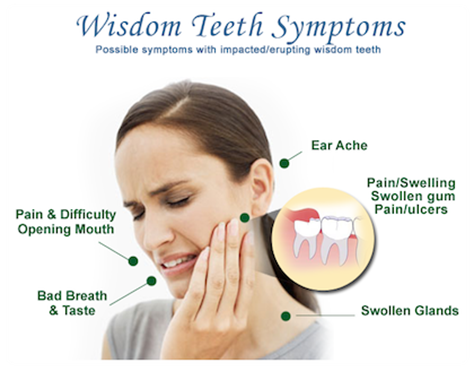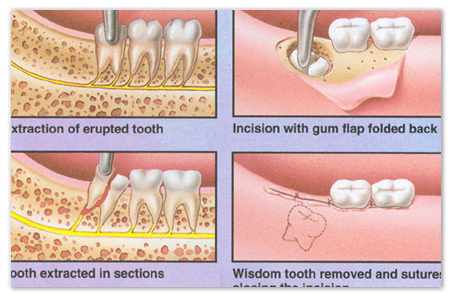Wisdom Teeth
 Wisdom teeth are a final set of teeth that erupt within the period between 17 and 25 years old. These teeth are rudimental, as they are a vestige of the ancient time when our ancestors had longer and stronger jaws that they needed for chewing rough natural food. If aligned properly, wisdom teeth pose no problem and can be helpful in the chewing process. However, they can be sheer trouble.
Wisdom teeth are a final set of teeth that erupt within the period between 17 and 25 years old. These teeth are rudimental, as they are a vestige of the ancient time when our ancestors had longer and stronger jaws that they needed for chewing rough natural food. If aligned properly, wisdom teeth pose no problem and can be helpful in the chewing process. However, they can be sheer trouble.
What’s bad about wisdom teeth?
The problem is that they often grow in a different way than the rest of the teeth. Some people have to deal with misaligned and impacted wisdom teeth. In the latter case, they never emerge from the gums, yet they do grow inside and may damage the neighboring teeth, surrounding soft tissue, and even the jawbone. They may press on nerves and cause permanent pain. In case there is but a tiny part of a tooth barely visible above the gum, it is more vulnerable to decay, and bacteria may penetrate deep into the dental tissue and the surrounding area. This may cause severe infections. Mainly, it happens due to the fact that these teeth are less reachable for a toothbrush or floss thread.
More often than not, wisdom teeth grow in an inward or outward position and have a crooked shape. They crowd the area behind the molars and cause discomfort. Misaligned and impacted wisdom teeth are of zero use, so they should be extracted.
Should they be removed?
Yes, they should, if there are clear signs of misalignment or impaction. It is strongly recommended for every young man and/or woman to undergo a check and see if their wisdom teeth are shaping up to be a nuisance. For example, the American Dental Association recommends people aged 16-19 to have their wisdom teeth evaluated, because at this stage these teeth have smaller roots and therefore are easier to extract.
How are they extracted?
The extraction procedure depends on the degree of misalignment/impaction, and it is outlined after a thorough evaluation. It should be carried out by an oral surgeon, and it requires local anesthesia. If no severe misalignment is observed, the extraction procedure will be pretty standard. In some cases, when a tooth is deeply embedded in the gum and jawbone, it can be removed in portions and with a bit of surrounding bone tissue. In severe and complicated cases, general anesthesia may be applied. After the operation, patients are usually asked to bite on a piece of soft material to minimize bleeding.
Post-extraction care
However, sometimes post-surgical complications do occur. One of the most common aggravations is dry socket. It develops when the blood clot goes away and exposes nerves and bone. It is a very painful condition. To prevent it, do the following simple aftercare procedures:
- Put an ice pack to the respective part of your cheek and hold it for about 20 minutes. Then put it away and wait for another 20 minutes. Repeat the procedure several times.
- If the area bleeds, apply gauze pads to it. They will absorb blood and prevent rough clotting.
- To prevent clot dislodging, do not eat, drink, or talk too much. Do not rinse the area too hard. Cut down on foods that crumble and may get into the socket.
- Take medications as advised by your doctor.
Some swelling, bleeding, and pain may persist for the next couple of days. However, if these conditions do not go away after a week or get worse, contact your dental health care provider immediately.
Wisdom Teeth Removal at Alpha Dental Care
If it is time for your wisdom teeth to come out, Dr. Bhamra can help you find the best available choice of treatment. In most cases removal of wisdom teeth is performed under local anesthesia, laughing gas (nitrous oxide/oxygen anesthesia) or general anesthesia. These options are discussed with you before the procedure is performed. Once the teeth are removed, suture is placed and your post operative kit will include prescription for pain, antibiotics and follow up appointment in one week.
Learn more about extractions, post operative care and safe sedation dentistry by contacting us either by phone 905-876-0200 or email This email address is being protected from spambots. You need JavaScript enabled to view it.

